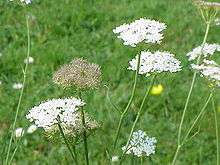Water dropwort
| Water dropwort | |
|---|---|
 | |
| Oenanthe aquatica | |
| Scientific classification | |
| Kingdom: | Plantae |
| (unranked): | Angiosperms |
| (unranked): | Eudicots |
| (unranked): | Asterids |
| Order: | Apiales |
| Family: | Apiaceae |
| Genus: | Oenanthe L., 1753 |
| Species | |
|
O. aquatica – Fine-leafed water dropwort | |

The water dropworts, Oenanthe /ɔɪˈnænθiː/, are a genus of plants in the family Apiaceae. Most of the species grow in damp ground, in marshes or in water.
Several of the species are extremely poisonous, the active poison being oenanthotoxin. The most notable of these is O. crocata, which lives in damp, marshy ground, and resembles celery with roots like a bunch of large white carrots. The leaves may be eaten safely by livestock, but the stems, and especially the carbohydrate-rich roots are much more poisonous. Animals familiar with eating the leaves may eat the roots when these are exposed during ditch clearance – one root is sufficient to kill a cow, and human fatalities are also known. It has been referred to as the most poisonous of all British plants,[1] and is considered particularly dangerous because of its similarity to several edible plants.[2]
The species O. javanica, commonly known as Chinese celery or Japanese parsley (seri; not to be confused with mitsuba or Japanese wild celery, a plant from a different genus) is edible and grown in several countries of eastern Asia, as well as in Italy and India, where the spring growth is relished as a vegetable.
Names
"Oenanthe" is derived from the Greek oinos "wine" and anthos "flower", from the wine-like scent of the flowers.[3]
The name "water dropwort" comes from the close resemblance of some of the smaller species (which mainly grow in wet ground) to dropwort (Filipendula vulgaris) (Rosaceae), an unrelated plant of dry grassland.
Sardonic grin
Scientists at the University of Eastern Piedmont in Italy wrote that they had identified hemlock water dropwort (Oenanthe crocata) as the plant responsible for producing the sardonic grin.[4][5] This plant is the most-likely candidate for the "sardonic herb", which was a neurotoxic plant used for the ritual killing of elderly people in Phoenician Sardinia. When these people were unable to support themselves, they were intoxicated with this herb and then dropped from a high rock or beaten to death. Criminals were also executed in this way.[6]
 Corky-fruited water dropwort (Oenanthe pimpinelloides)
Corky-fruited water dropwort (Oenanthe pimpinelloides)- Hemlock water dropwort (Oenanthe crocata) in spring
References
- ↑ "Information Sheet: 31 Hemlock Water Dropwort (Oenanthe crocata)" (pdf). Centre for Ecology and Hydrology. 2005. Retrieved September 28, 2011.
Oenanthe crocata [...] is the most toxic plant in Britain to both humans and animals.
- ↑ Wright, John (2010), Hedgerow, Bloomsbury, p. 171, ISBN 978-1-4088-0185-7
- ↑ "Dropwort, Hemlock Water". A Modern herbal. Botanical.com. Retrieved 2008-02-05.
- ↑ News Scan Briefs: Killer Smile, Scientific American, August 2009
- ↑ G. Appendino; F. Pollastro; L. Verotta; M. Ballero; A. Romano; P. Wyrembek; K. Szczuraszek; J. W. Mozrzymas & O. Taglialatela-Scafati (2009). "Polyacetylenes from Sardinian Oenanthe fistulosa: A Molecular Clue to risus sardonicus". Journal of Natural Products. 72 (5): 962–965. doi:10.1021/np8007717. PMC 2685611
 . PMID 19245244.
. PMID 19245244. - ↑ Owen, James (2009-06-02). "Ancient Death-Smile Potion Decoded?". National Geographic News. Retrieved 2009-10-18.
External links
![]() Media related to Water dropwort at Wikimedia Commons
Media related to Water dropwort at Wikimedia Commons
- Downs, C.; Phillips, J.; Ranger, A.; Farrell, L. (2002). "A hemlock water dropwort curry: a case of multiple poisoning". Emergency Medicine Journal. 19 (5): 472–473. doi:10.1136/emj.19.5.472. PMC 1725941
 . PMID 12205016.
. PMID 12205016. - article National Geographic: poisoning in history of Italy